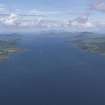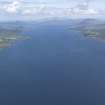Following the launch of trove.scot in February 2025 we are now planning the retiral of some of our webservices. Canmore will be switched off on 24th June 2025. Information about the closure can be found on the HES website: Retiral of HES web services | Historic Environment Scotland
Rum, General
General View (Period Unassigned)
Site Name Rum, General
Classification General View (Period Unassigned)
Alternative Name(s) Rhum
Canmore ID 107964
Site Number NM39NE 33
NGR NM 3600 9600
Datum OSGB36 - NGR
Permalink http://canmore.org.uk/site/107964
- Council Highland
- Parish Small Isles
- Former Region Highland
- Former District Lochaber
- Former County Inverness-shire
RUM
Wildest of the Small Isles, Rum lies between Eigg and Canna, its skyline swept into volcanic peaks wrought of the same metal as the Cuillin. The only sheltered anchorage lies at the head of Loch Scresort, notched into the eastern side of the lozenge-shaped isle. Here, Scotland's earliest known human settlement has been found - a Mesolithic site some 8-9,000 years old. But it was Norse settlers who gave the hills and places their names, though little material evidence of their occupation has been unearthed. Archaeological sites abound, however, and the island is littered with the ruins of former dwellings - including at least 400 shieling huts. Rum formed part of the lands granted in the 13 th century to Ranald MacRuari, progenitor of the Clanranalds, who held it until the 15th century. Then John Garbh, son of the 7th Chief of the Macleans of Duart, swapped it for a birlinn (which Clanranald soon found to be rotten). Collapse of the Lordship led to increased clan feuding, notably between the Macdonalds and Macleans. Eventually, in 1695, Rum was confirmed as part of Maclean of Coll's lands with a charter from Argyll. In 1772 the island had nine hamlets, and a few decades later the population was at its peak. Overcrowded and poverty stricken, it was leased in 1826 to sheepfarmer Dr Lachlan Maclean of Gallanach, Coll, who organised two sweeping clearances that year and in 1828, to make way for 8,000 Blackface sheep. Old townships were abandoned and their occupants removed to Cape Breton. The population now amounted to a handful of Lowland shepherds and just one remaining native family. Lachlan Maclean built Kinloch House in 1826, '… a good dwelling house, with splendid offices' (NSA), standing close to where the Kinloch river flows into Loch Scresort (for a fuller contemporary description, see p.162). Only the gate piers survive in a thicket - its former flower garden - behind the castle; the rest was pulled down in 1891.Maclean 'spared neither pains nor expense in draining, fencing and planting around his residence …' but by 1839 the farm had failed and, bankrupted, he abandoned the depopulated isle. It was sold in 1845 to the 2nd Marquis of Salisbury, lured by the potential for quite a different sort of activity. Once teeming with deer, Rum had long ago been a favoured deer hunting ground of the Clanranalds; now deer were reintroduced. But the Victorian concept of a sporting estate was to manifest itself here in a manner quite unprecedented in the Hebrides. Still reeling from the devastating effects of the potato blight, those islanders not given assistance to emigrate to Canada were dragooned into employment: draining and planting, laying tracks and paths, improving cottages and, in 1847, constructing across a ravine the curving breastwork of what is now known as the Salisbury dam, 60 m of double-skinned walling (with earthern core), intended to divert the waters of the Kilmory River through a lade into the Kinloch River, and so create a good salmon river. It remains today an abandoned ruin, allegedly breached shortly after the reservoir had filled. Rum was sold in 1870 to Capt. Farquhar Campbell, one of the Campbells of Ormsary (sugar; slave trade) who had bought Aros on Mull in 1856. Campbell let out the sheep farms and sporting, and died in 1882. In 1888 a former tenant, the Lancashire textile machinery industrialist John Bullough, became the owner, and his family is now most famously associated with the island. Lady Bullough sold Rum in 1957 to the Nature Conservancy, now Scottish Natural Heritage, which, among many other achievements here, has planted over a million trees, re-introduced the sea eagle to Scotland and operated a long-term programme of research into the habits of red deer. Today, the island has a small population, mostly associated with this government agency.
Taken from "Western Seaboard: An Illustrated Architectural Guide", by Mary Miers, 2008. Published by the Rutland Press http://www.rias.org.uk



















































